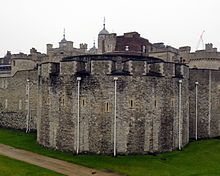Brass mount
Brass Mount , originally The Mount , is a bastion in the northeastern outer wall of the fortress of the Tower of London . The bastion served as a gun post and in the 20th century as a warehouse. The storage of firearms there was the last military use of the Tower of London. At the turn of the millennium, the camp was cleared. The bastion was named presumably by the guns of brass (Engl. Brass ) who were stationed there in the 18th century.
The bastion was built under the English King Edward I. At the end of the 13th century, he had the outer walls of the tower reinforced in order to provide additional protection for the newly moved Royal Mint . While the older bastion Legge's Mount in the northwest of the tower was only strengthened, the three towers that had previously protected the fortress in the east were replaced by a new bastion.
The bastion is made of brick , making it one of the first major buildings in the UK to be built from the material. Brass Mount protrudes further into the trench than its western counterpart Legge's Mount. It may have been a stand-alone structure at first and was only later connected to the outer walls of the tower. At the time of its construction, the bastion already had an impressive gun battery. When in the Middle Ages Brass Mount was structurally connected to the rest of the fortress cannot be proven. In 1597 it was part of the fortress. At the end of the 16th century, the defenses of the Tower of Altered Warfare were touched. Brass Mount has been reinforced to accommodate more powerful guns and another gun gallery on the ground floor has been added. At the same time, the remaining cavities inside were filled with earth. The now compact structure should offer stronger resistance to impacts by guns.
As early as 1715, however, the backfilling was partially removed in order to make space for a ladder between the two levels on the bastion and on the ground floor. In the 19th century this was replaced by a staircase. In 1914, when the First World War broke out, the War Office had the soil backfilled completely removed. It built three floors inside, which were used to store rifles.
Brass Mount was recognized literarily in the 19th century. In the bestseller The Tower of London, A Historical Romance , the author William Harrison Ainsworth let the attack to liberate Jane Gray take place over the Brass Mount. The literary bastion thus experienced more battles than the real one.
Remarks
- ^ John Britton and Edward Wedlake Brayley: Memoirs of the Tower of London, London 1830, p. 236
- ^ A b Edward Impey, Geoffrey Parnell: The Tower of London. The official illustrated history. Merrell, London 2000, ISBN 1-85894-106-7 , pp. 44-46
- ^ Simon Bradley, Nikolaus Pevsner: London 1, The city of London, 1997, London: Penguin. ISBN 0140710922 , p. 359
- ^ Edward Impey, Geoffrey Parnell: The Tower of London. The official illustrated history. Merrell, London 2000, ISBN 1-85894-106-7 , p. 63
- ^ Edward Impey, Geoffrey Parnell: The Tower of London. The official illustrated history. Merrell, London 2000, ISBN 1-85894-106-7 , p. 111
- ^ Edward Impey, Geoffrey Parnell: The Tower of London. The official illustrated history. Merrell, London 2000, ISBN 1-85894-106-7 , p. 113
Web links
Coordinates: 51 ° 30 ′ 31.6 " N , 0 ° 4 ′ 28.9" W.

